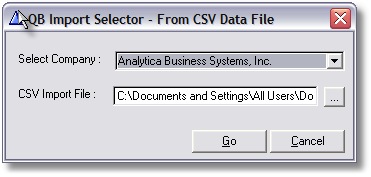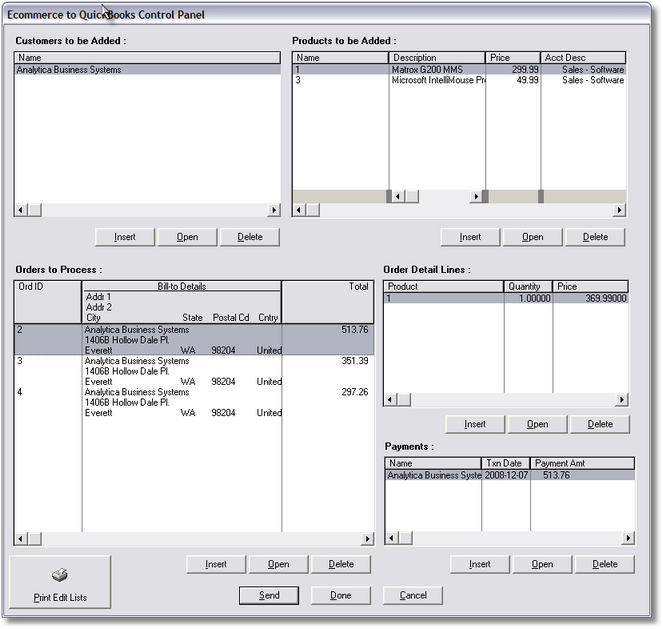|
Process from CSV File |

|

|
QB Import Selector - From CSV Data File
This is the form you use to select the comma-separated-value file that contains the order or invoice data you want to export into QuickBooks.
QB Director can import sales data from any system that can export to a comma-separated-values file. The record structure of the comma-separated values is defined in the meta data files installed with QB Director.
Currently, QB Director installs with meta data definitions for the Order Details CSV file from eCommerce Templates. Custom definitions are available from Analytica Business Systems beginning at US$99.00. This allows QB Director to connect any shopping cart or sales order system to your QuickBooks company.

Here is where you select the AR Control Company definition, the date ranges and the order statuses for which to import and process sales orders:
Select the Company that represents the definition you have set up for the desired transfer from sales order system/shopping cart to QuickBooks Company. You may have any number of companies, i.e. transfer definitions, listed here.
Then, select the Comma-Separated-Values file that contains your sales orders data. You may click the ellipsis button (...) to the right of the entry field to browse to the location of the import file.
You will notice that there is no date range or order status parameters to enter on this form. That's because the contents of the CSV file are under your control. When you define the selection criteria in the admin section of your sales order system for the export to CSV, make sure your are exporting only those orders that you wish to post to QuickBooks. However, if some unwelcome orders "leak" out that you do not want to post to QuickBooks, you will have another chance to delete any orders, order detail, customers or products in the Control Panel, before sending to QuickBooks.
When you are ready, click "Go".
QB Director will now import your sales data as you have just specified it, then connect to QuickBooks to do some data validation.
The version of QuickBooks that you are exporting to will determine what you see next. For instance, if you are integrating with QuickBooks Online Edition, you will see the following:

If, for instance, you are exporting to QuickBooks Desktop 2009, the QuickBooks Interface will attempt to connect directly to QuickBooks and you won't be required to do anything. Whatever QuickBooks edition you are exporting to, follow the directions on the window. Requests for user interaction similar to the window above are QuickBooks interface windows, and it's beyond the scope of this document to provide QuickBooks-specific instructions.

Control Panel
The Control Panel allows you to review all aspects of the imported sales order data to be sent to QuickBooks for integration, and to make any corrections or additions to Customers, Products, Orders, Order Detail Lines, and Payments, or even delete records that you don't want to integrate with QuickBooks.
You may also print edit lists, which may also serve as transaction registers, for Customers to be Added, Products to be Added, Orders to Process, and Payments, using the "Print Edit Lists" button.
For details on editing Customers, Products, Orders, Order Detail Lines or Payments, click anywhere in the corresponding region in the image above.
When all the sales order data in the Control Panel are correct to your satisfaction, press the "Send" button to send it all to QuickBooks.